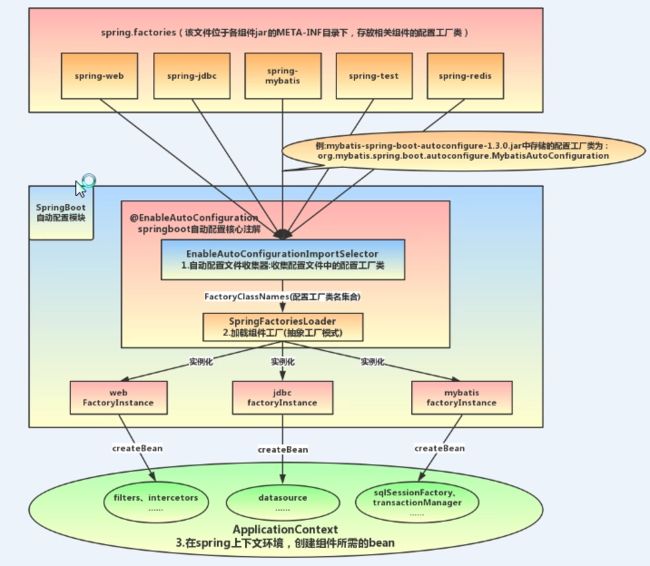一、了解SpringBoot
Spring Boot是一个简化Spring开发的框架。用来监护spring应用开发,约定大于配置,去繁就简,just run 就能创建一个独立的,产品级的应用。我们在使用Spring Boot时只需要配置相应的Spring Boot就可以用所有的Spring组件,简单的说,spring boot就是整合了很多优秀的框架,不用我们自己手动的去写一堆xml配置然后进行配置。从本质上来说,Spring Boot就是Spring,它做了那些没有它你也会去做的Spring Bean配置。
二、从入口开始
@SpringBootApplication
public class SpringBootWebApplication {
public static void main(String[] args) {
SpringApplication application = new SpringApplication(SpringBootWebApplication.class);
application.run(args);
}
}
从以上代码中可以看出SpringBoot的启动核心要素有两个:
- @SpringBootApplication注解
- SpringApplication.run()
下面,就针对这两个核心要素来展开分析。
三、@SpringBootApplication拆轮子
进入@SpringBootApplication注解类,查看原代码
@Target(ElementType.TYPE)
@Retention(RetentionPolicy.RUNTIME)
@Documented
@Inherited
@SpringBootConfiguration
@EnableAutoConfiguration
@ComponentScan(excludeFilters = {
@Filter(type = FilterType.CUSTOM, classes = TypeExcludeFilter.class),
@Filter(type = FilterType.CUSTOM, classes = AutoConfigurationExcludeFilter.class) })
public @interface SpringBootApplication {
}
可以发现,@SpringBootApplication主要由3个注解组成
- @SpringBootConfiguration
- @EnableAutoConfiguration
- @ComponentScan
1. @SpringBootConfiguration
它就是JavaConfig形式的Spring Ioc容器的配置类使用的那个@Configuration,这里的启动类标注了@Configuration之后,本身其实也是一个IoC容器的配置类。xml和注解实现bean的定义如下:
2. @EnableAutoConfiguration
首先,打开@EnableAutoConfiguration注解类,查看原代码
@SuppressWarnings("deprecation")
@Target(ElementType.TYPE)
@Retention(RetentionPolicy.RUNTIME)
@Documented
@Inherited
@AutoConfigurationPackage
@Import(EnableAutoConfigurationImportSelector.class)
public @interface EnableAutoConfiguration {
这里的重要点是@Import发挥的作用,他负责收集和注册特定场景相关的bean定义。其中的EnableAutoConfigurationImportSelector.class可以帮助SpringBoot应用将所有符合条件的@Configuration配置都加载到当前SpringBoot创建并使用的IoC容器。
借助于Spring框架原有的一个工具类-SpringFactoriesLoader的支持很智能的自动配置。
SpringFactoriesLoader其主要功能就是从指定的配置文件META-INF/spring.factories加载配置。将其中org.springframework.boot.autoconfigure.EnableutoConfiguration对应的配置项通过反射(Java Refletion)实例化为对应的标注了@Configuration的JavaConfig形式的IoC容器配置类,然后汇总为一个并加载到IoC容器。
四、SpringBootApplication.run()
@EnableDiscoveryClient
@EnableAspectJAutoProxy(exposeProxy = true, proxyTargetClass = true)
public class Application extends SpringBootServletInitializer {
public static void main(String[] args) {
new Application()
.configure(new ApplicationBuilder(Application.class))
.run(args);
}
}
run()方法之前,首先是配置SpringBootApplication实例,实际上会调到initialize(sources)。
private void initialize(Object[] sources) {
if (sources != null && sources.length > 0) {
this.sources.addAll(Arrays.asList(sources));
}
this.webEnvironment = deduceWebEnvironment();
setInitializers((Collection) getSpringFactoriesInstances(
ApplicationContextInitializer.class));
setListeners((Collection) getSpringFactoriesInstances(ApplicationListener.class));
this.mainApplicationClass = deduceMainApplicationClass();
}
SpringBootApplication初始化主要做了三件事:
- 根据classpath下是否存在(ConfigurableWebApplicationContext)判断是否要启动一个web applicationContext。
- SpringFactoriesInstances加载classpath下所有可用的ApplicationContextInitializer
- SpringFactoriesInstances加载classpath下所有可用的ApplicationListener
完成后调用run()
public ConfigurableApplicationContext run(String... args) {
if (this.running.get()) {
// If already created we just return the existing context
return this.context;
}
configureAsChildIfNecessary(args);
if (this.running.compareAndSet(false, true)) {
synchronized (this.running) {
// If not already running copy the sources over and then run.
this.context = build().run(args);
}
}
return this.context;
}
事实上,run是围绕ConfigurableApplicationContext来展开的,那么,我们看下ConfigurableApplicationContext的run里面做了哪些事情
/**
* Run the Spring application, creating and refreshing a new
* {@link ApplicationContext}.
* @param args the application arguments (usually passed from a Java main method)
* @return a running {@link ApplicationContext}
*/
public ConfigurableApplicationContext run(String... args) {
StopWatch stopWatch = new StopWatch();
stopWatch.start();
ConfigurableApplicationContext context = null;
FailureAnalyzers analyzers = null;
configureHeadlessProperty();
SpringApplicationRunListeners listeners = getRunListeners(args);
listeners.starting();
try {
ApplicationArguments applicationArguments = new DefaultApplicationArguments(
args);
ConfigurableEnvironment environment = prepareEnvironment(listeners,
applicationArguments);
Banner printedBanner = printBanner(environment);
context = createApplicationContext();
analyzers = new FailureAnalyzers(context);
prepareContext(context, environment, listeners, applicationArguments,
printedBanner);
refreshContext(context);
afterRefresh(context, applicationArguments);
listeners.finished(context, null);
stopWatch.stop();
if (this.logStartupInfo) {
new StartupInfoLogger(this.mainApplicationClass)
.logStarted(getApplicationLog(), stopWatch);
}
return context;
}
catch (Throwable ex) {
handleRunFailure(context, listeners, analyzers, ex);
throw new IllegalStateException(ex);
}
}
1. 启动并配置SpringApplicationRunListeners
首先遍历初始化过程中加载的SpringApplicationRunListeners,然后调用starting(),开始监听springApplication的启动。加载SpringBoot配置环境(ConfigurableEnvironment),如果是通过web容器发布,会加载StandardEnvironment。将配置环境(Environment)加入到监听器对象中(SpringApplicationRunListeners)。
2. banner属性的设置
private Banner printBanner(ConfigurableEnvironment environment) {
if (this.bannerMode == Banner.Mode.OFF) {
return null;
}
ResourceLoader resourceLoader = this.resourceLoader != null ? this.resourceLoader
: new DefaultResourceLoader(getClassLoader());
SpringApplicationBannerPrinter bannerPrinter = new SpringApplicationBannerPrinter(
resourceLoader, this.banner);
if (this.bannerMode == Mode.LOG) {
return bannerPrinter.print(environment, this.mainApplicationClass, logger);
}
return bannerPrinter.print(environment, this.mainApplicationClass, System.out);
}
3. ConfigurableApplicationContext实例的创建
回顾一下run的第一段代码,在run之前会检查ConfigurableApplicationContext实例是否存在,其实整个SpringBoot都存在这这种单例的设计思路。下面看一下ConfigurableApplicationContext的创建代码:
/**
* Strategy method used to create the {@link ApplicationContext}. By default this
* method will respect any explicitly set application context or application context
* class before falling back to a suitable default.
* @return the application context (not yet refreshed)
* @see #setApplicationContextClass(Class)
*/
protected ConfigurableApplicationContext createApplicationContext() {
Class contextClass = this.applicationContextClass;
if (contextClass == null) {
try {
contextClass = Class.forName(this.webEnvironment
? DEFAULT_WEB_CONTEXT_CLASS : DEFAULT_CONTEXT_CLASS);
}
catch (ClassNotFoundException ex) {
throw new IllegalStateException(
"Unable create a default ApplicationContext, "
+ "please specify an ApplicationContextClass",
ex);
}
}
return (ConfigurableApplicationContext) BeanUtils.instantiate(contextClass);
}
根据webEnvironment是否是web环境创建默认的contextClass
,AnnotationConfigEmbeddedWebApplicationContext(通过扫描所有注解类来加载bean)和ConfigurableWebApplicationContext),最后通过BeanUtils实例化上下文对象,并返回。
4. prepareContext()
private void prepareContext(ConfigurableApplicationContext context,
ConfigurableEnvironment environment, SpringApplicationRunListeners listeners,
ApplicationArguments applicationArguments, Banner printedBanner) {
context.setEnvironment(environment);
postProcessApplicationContext(context);
applyInitializers(context);
listeners.contextPrepared(context);
if (this.logStartupInfo) {
logStartupInfo(context.getParent() == null);
logStartupProfileInfo(context);
}
// Add boot specific singleton beans
context.getBeanFactory().registerSingleton("springApplicationArguments",
applicationArguments);
if (printedBanner != null) {
context.getBeanFactory().registerSingleton("springBootBanner", printedBanner);
}
// Load the sources
SetprepareContext()方法将listeners、environment、applicationArguments、banner等重要组件与上下文对象关联。
5. refreshContext(context)
private void refreshContext(ConfigurableApplicationContext context) {
refresh(context);
if (this.registerShutdownHook) {
try {
context.registerShutdownHook();
}
catch (AccessControlException ex) {
// Not allowed in some environments.
}
}
}
往下会调到refresh()的执行
@Override
public void refresh() throws BeansException, IllegalStateException {
synchronized (this.startupShutdownMonitor) {
// Prepare this context for refreshing.
prepareRefresh();
// Tell the subclass to refresh the internal bean factory.
ConfigurableListableBeanFactory beanFactory = obtainFreshBeanFactory();
// Prepare the bean factory for use in this context.
prepareBeanFactory(beanFactory);
try {
// Allows post-processing of the bean factory in context subclasses.
postProcessBeanFactory(beanFactory);
// Invoke factory processors registered as beans in the context.
invokeBeanFactoryPostProcessors(beanFactory);
// Register bean processors that intercept bean creation.
registerBeanPostProcessors(beanFactory);
// Initialize message source for this context.
initMessageSource();
// Initialize event multicaster for this context.
initApplicationEventMulticaster();
// Initialize other special beans in specific context subclasses.
onRefresh();
// Check for listener beans and register them.
registerListeners();
// Instantiate all remaining (non-lazy-init) singletons.
finishBeanFactoryInitialization(beanFactory);
// Last step: publish corresponding event.
finishRefresh();
}
catch (BeansException ex) {
if (logger.isWarnEnabled()) {
logger.warn("Exception encountered during context initialization - " +
"cancelling refresh attempt: " + ex);
}
// Destroy already created singletons to avoid dangling resources.
destroyBeans();
// Reset 'active' flag.
cancelRefresh(ex);
// Propagate exception to caller.
throw ex;
}
finally {
// Reset common introspection caches in Spring's core, since we
// might not ever need metadata for singleton beans anymore...
resetCommonCaches();
}
}
}
bean的实例化完成IoC容器可用的最后一道工序。
6. afterRefresh()
/**
* Called after the context has been refreshed.
* @param context the application context
* @param args the application arguments
*/
protected void afterRefresh(ConfigurableApplicationContext context,
ApplicationArguments args) {
callRunners(context, args);
}
private void callRunners(ApplicationContext context, ApplicationArguments args) {
Listcontext刷新完成后启动各个环节任务
7.收尾,并返回ConfigurableApplicationContext对象
listeners.finished(context, null);
stopWatch.stop();
if (this.logStartupInfo) {
new StartupInfoLogger(this.mainApplicationClass)
.logStarted(getApplicationLog(), stopWatch);
}
return context;
总结
SpringBoot启动的核心实际上就是ConfigurableApplicationContext,整个流程都是围绕ConfigurableApplicationContext展开,ConfigurableApplicationContext关联着所有的重要操作。
